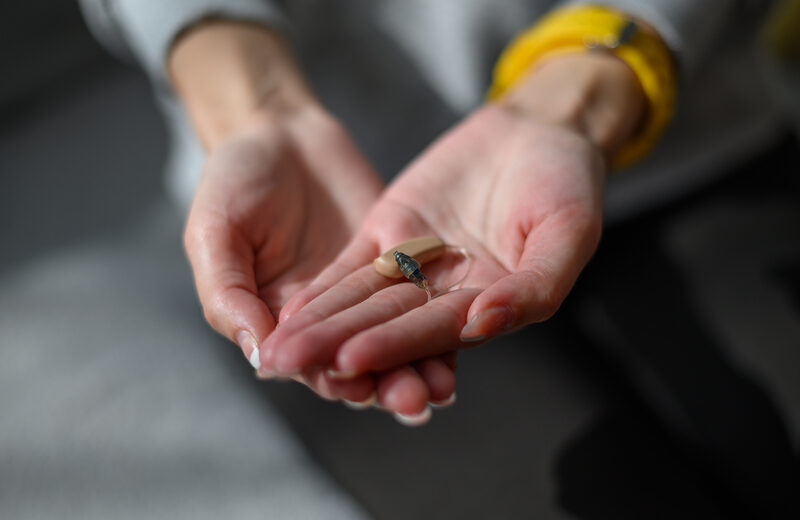It can be a very rough time when your hearing aids get wet. Any liquid getting into the circuitry can create shorts and corrode metal connections. Typical first reactions to finding your device emersed in water are panic, fear, and depression. These feelings are justified because moisture in even tiny amounts is enough to damage hearing aids permanently. As bad as it can be when you have to pick up your device from a puddle, grab it after that drink spilled, or worse, have to fish it out of the commode, not all is lost. In this article, we will discuss the tips and techniques you can use to mitigate damage and potentially save your waterlogged hearing aids from a watery death.
Helpful Tips for Waterlogged Hearing Aids
Rechargeable Hearing Aids with Non-Removable Batteries
Hearing aids come in two basic types; those with removable batteries and rechargeable devices with non-removable ones. The presence of batteries will limit what steps you can take to save your device. Follow these steps to give your waterlogged hearing aids a fighting chance for survival.
1- Don’t Panic
Once your hearing aid becomes wet, time is of the essence. As the water, which is a conductor, crosses over wires and circuits, it will start creating shorts and malfunctions in the electronics. Once this process begins, the errors and damage made can quickly become permanent and, if left unchecked for too long, will ruin your hearing aids.
2- Remove Every Component You Can
Peripheral components and add-ons can trap water, making it harder to dry them out. Make sure to remove cases, covers, and anything that generally can be taken out without damaging your hearing aids.
3- Dry the Outside First
For devices with permanent batteries, getting them dry as fast as possible is vital. Depending on how far the water has penetrated, this can be easier said than done. Wrap the moistened device in a clean and dry towel. Hold Firmly, and shake vigorously. If you are lucky, the water didn’t get past the case, leaving you with a close call.
4- Drying the Inside
The last step in this process involves a drying medium. There are three schools of thought on this matter; Dehumidifiers, silica gel, and rice. Each has its benefits and hindrances. Dehumidifiers are generally considered the best option, but not all dehumidifiers are equal and effective machines can be pricey. Silica gel, sold as desiccant disks, will do the job but will have a hard time with a fully saturated device. Rice is the cheapest and the least reliable; basically, stick it in and cross your fingers. Place your wet hearing aids in your drying medium and leave them overnight.
Devices With Removable Batteries
Dealing with hearing aids with removable batteries is a bit more involved but has a much better chance of recovery. The absence of a battery will allow for much more drastic techniques to attempt to save the device.
1- Don’t Panic
Shock and panic can make you waste the precious moments you need to save your hearing aids because, if you move fast enough, you have a real chance at recovery.
2- Remove The Battery and Every Component You Can
Pulling out the battery is the first thing to do after recovering it from a water source. Eliminating the power will help prevent shorts in the circuit, protecting the delicate components from damage. After the battery, remove any covers or parts you can without damaging your device. Leave the battery compartment door open until you are sure it’s dry.
3- Dry the Outside First
While this step is not as vital as for devices with non-removable batteries, it’s still essential to dry the outside with a dry towel or cloth and inspect the inside of the battery compartment. This will give you an idea of how much water has gotten inside, helping determine how much more you have to do to save your equipment.
4- Removing Water From the Inside
Even if you have determined that your hearing aid is entirely soaked, there is still no need to panic. We have found a method recommended by some of the most experienced techs in the industry. Sometimes called the alcohol immersion technique, it’s a surefire way to get every drop of water out of your devices.
#1. Make sure the battery has been removed, along with all cases, covers, and add-ons.
#2. Place the device inside a plastic bag, preferably a ziplock.
#3. Pour enough isopropyl or rubbing alcohol to immerse the device.
#4. Close the bag, leaving enough air so that sloshing can occur.
#5. Shake the bag vigorously for at least 30 seconds.
#6. Hold the device and bag at the bottom, and quickly pour out the liquid. Any water inside the hearing aid will be pushed out by the alcohol, leaving it to float on the top.
#7. Remove from the bag and place on a paper towel or in a hearing aid dehydrator for at least 6 hours.
If you are a bit uncomfortable with this method or feel that your issue isn’t that bad, just follow the steps for hearing aids with non-removable batteries. Either way, within 24 hours, you will know if you need replacements or not. If new devices are required, it might be a good time to look into waterproof and resistant ones.





